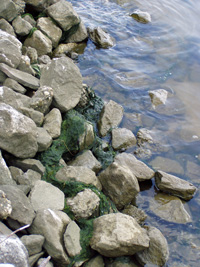June
24 , 2004 |
The macroalgae bloom was first identified by MDE in May on Frog Mortar Creek, Middle River (see HAB News from May 13, 2004: "Filamentous Green Algae Blooms observed in Frog Mortar Creek and South River."). By May 28, citizen calls identified filamentous algae also blooming in Hogpen Creek, Frog Mortar Creek, Stansbury Creek, Sue Creek and Dark Head Cover in Middle River. Rhizoclonium and Cladophora are non-toxic macroalgae. The algae represents a nuisance and inconvenience to recreational activities. Dense algal growth forming on submerged aquatic vegetation may limit sunlight passing through the water that would otherwise reach the leaves and subsequently impact growth and survival of the plants in this region. |

 Maryland
Department of the Environment (MDE) investigated a report of poor water
quality on June 17 that was determined to be a combination of algal blooms
on Seneca Creek, Baltimore County. The dominant algae washing up on shore
was a filamentous macroalgae, Rhizoclonium, with a second macroalgae,
Cladophora, also identified. Simultaneously on Seneca Creek,
a blue-green algal bloom has been detected with Microcystis dominating
the plankton at 304,628 cells per milliliter (see HAB News from June 24,
2004: "
Maryland
Department of the Environment (MDE) investigated a report of poor water
quality on June 17 that was determined to be a combination of algal blooms
on Seneca Creek, Baltimore County. The dominant algae washing up on shore
was a filamentous macroalgae, Rhizoclonium, with a second macroalgae,
Cladophora, also identified. Simultaneously on Seneca Creek,
a blue-green algal bloom has been detected with Microcystis dominating
the plankton at 304,628 cells per milliliter (see HAB News from June 24,
2004: "